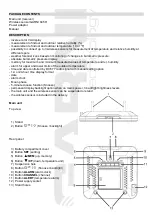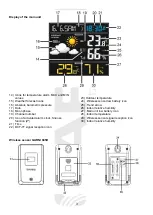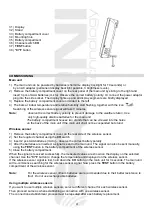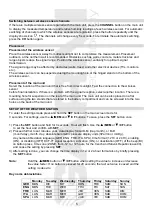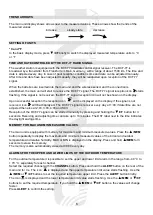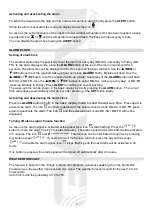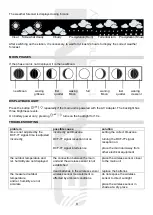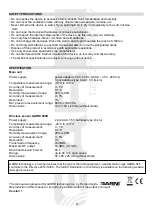
4
31) Display
32) Stand
33) Battery compartment cover
34) Mounting hole
35) Battery compartment
36) Channel switch
CH
37)
TEST
button
38)
°C/°F
button
COMMISSIONING
Main unit
1) The main unit can be powered by batteries (short-time display backlight for 10 seconds) or
by an AC adapter (permanent display backlight possible, 3 brightness levels).
2) Remove the battery compartment cover on the rear panel of the main unit by sliding to the right and
insert 3 pcs of AAA batteries (micro). Observe the correct battery polarity. Or connect the power adaptor
plug into the side socket. The display lights up and all display segments are briefly displayed.
3) Replace the battery compartment cover and slide it to the left
4) The bars at indoor temperature and relative humidity start flashing, together with the icon
.
Searching of the wireless sensor signal will take 3 minutes.
Note:
observe the correct battery polarity to prevent damage to the weather station. Use
only high-quality alkaline batteries for the main unit
The battery compartment houses two stands that can be screwed into the holes
on the back of the main unit if the main unit shall not be suspended but stand.
Wireless sensor
1) Remove the battery compartment cover on the rear side of the wireless sensor.
2) Set the required channel using the
CH
switch
3) Insert 2 pcs AAA batteries (micro) – observe the correct battery polarity
4) After the batteries are inserted, a signal is sent to the main unit. The signal can also be sent manually,
using the
TEST
button in the battery compartment of the wireless sensor
5) Close the battery compartment.
When the signal is received successfully, the measured values are shown on the display on the selected
channel. Use the
°C/°F
button to change the temperature unit displayed on the wireless sensor.
If the wireless sensor signal is lost, hold down the
CH
button on the main unit for 3 seconds. The main unit
will re-commence searching for the wireless sensor signal. Now press the
TEST
button in the battery
compartment of the wireless sensor.
Note:
For the wireless sensor, lithium batteries are recommended due to their better resistance to
frost. Do not use rechargeable batteries.
Using multiple wireless sensors
If you want to use multiple wireless sensors, select a different channel for each wireless sensor.
Then proceed same as when establishing a connection with one wireless sensor.
The connection establishment process must be repeated after each battery replacement.


